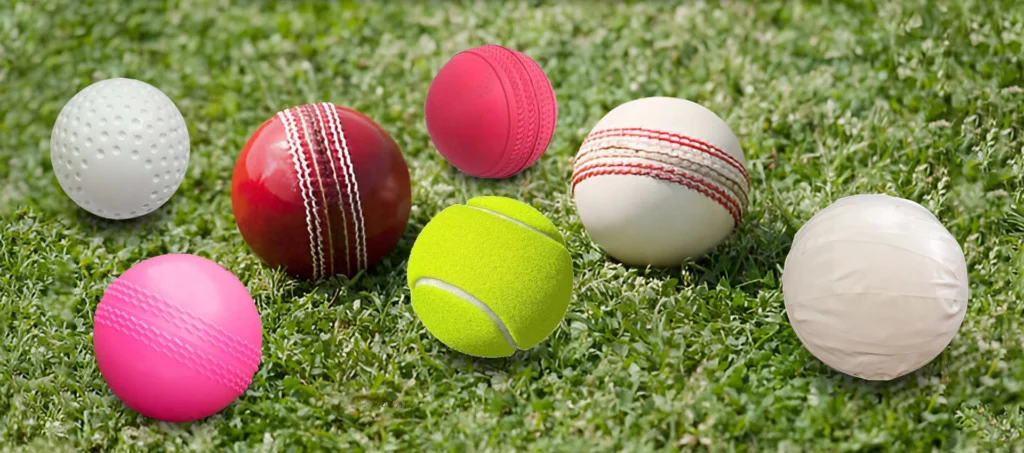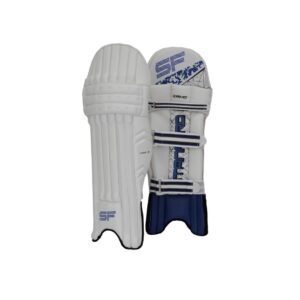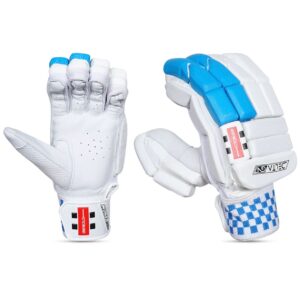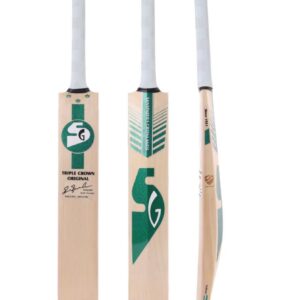Cricket is a fun game, and just like bats and stumps, the ball used in the game is very important. Did you know there are different types of cricket balls for different matches and conditions? Some balls swing more, some shine better, and others are perfect for practice or indoor games.
Let’s explore the names of different types of cricket balls and when they are used.
1) Red Cricket Ball
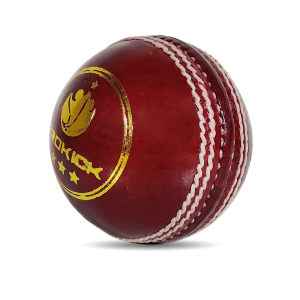
The red cricket ball is the traditional ball used in Test matches and first-class cricket. It is made of leather, typically dyed red, and is known for its durability and ability to swing in the air. The red ball is used in longer format games due to its ability to maintain its shape and hardness over extended periods of time. It is also said to provide better visibility for both the batsmen and fielders, especially in day-night matches.
Example: SG Test Ball, Dukes Red Ball
Key Features
- Good swing and seam movement in favorable conditions.
- Retains its hardness and shape longer than other balls.
- Ideal for day matches as it is visible in natural light.
2) White Cricket Ball

The white cricket ball is typically used in limited-overs matches, such as One Day Internationals (ODIs) and T20s. It is made of leather, dyed white, and is known for its ability to maintain its shine and swing for a shorter duration compared to the red ball. The white ball is used in shorter format games to help aid visibility under floodlights and to provide a greater opportunity for bowlers to extract movement off the pitch.
Example: Kookaburra White Ball, SG ODI Ball
Key Features
- Perfect for day-night matches.
- Looks bright under stadium lights.
- Swings in the early overs but wears out faster.designed to provide better visibility under floodlights and during day-night matches. It also tends to swing a bit more than the red ball.
3) Pink Cricket Ball

The pink cricket ball is used for matches that start in the afternoon and continue into the night, called day-night Test matches. It’s treated to keep its shine and visibility better under lights than a red ball.
Example: SG Pink Ball, Kookaburra Pink Ball
Key Features
- Better visibility during night sessions.
- Retains shine for longer than other balls.
- Offers decent swing, especially in the early overs.
4) Training Cricket Balls

Training balls are used during practice to help players learn and improve their skills. These balls are often made of rubber or taped tennis balls. They are lightweight and soft, making them safe to use for beginners and children.
Examples: Wind Ball, Taped Tennis Ball
Key Features
- Lightweight and safe for practice.
- Available in various materials like rubber or soft plastic.
- Commonly used for coaching kids and beginners.
5) Indoor Cricket Balls

Indoor cricket balls are soft and lightweight. These are made to avoid breaking things or hurting players in indoor spaces. They bounce less and are easy to handle.
Key Features
- Soft and lightweight to avoid injuries and damage.
- Provides limited bounce, suitable for indoor environments.
- Ideal for casual indoor games and training.
6) Rubber Cricket Balls

Rubber balls are perfect for kids and beginners. These are strong and safe, making them great for learning the game. They can also be used on hard surfaces like streets or cement pitches.
Key Features
- Safe and weather-resistant.
- Great for casual games and practice.
- Perfect for beginners.
7) Seamless Cricket Balls
Seamless cricket balls have no raised seam. They provide a smooth and consistent bounce, making them ideal for certain types of matches where players need more control over the ball’s movement.
Key Features
- Bounces evenly every time.
- Less swing and seam movement.
- Great for indoor games or specific formats.
8) Plastic Cricket Balls
Plastic balls are lightweight and perfect for street cricket or casual matches with friends. These balls are safe for children and don’t break anything easily, making them ideal for fun games.
Key Features
- Cheap, light, and fun to play with.
- Safe for kids and won’t cause damage.
- Great for backyard or street cricket.
9) Heavy Training Balls
These heavy balls help players build their arm and wrist strength. They are heavier than normal cricket balls and are often used during special training sessions by professional players.
Key Features
- Helps build muscles for stronger throws and shots.
- Used by professionals to improve strength.
How to Choose the Right Cricket Ball?
Choosing the right ball depends on where and how you are playing:
- For Professional Matches: Use a red ball for Test matches, a white ball for ODIs or T20s, and a pink ball for day-night Tests.
- For Practice: Use rubber balls or taped tennis balls.
- For Indoor Games: Use soft indoor balls to avoid breaking things.
- For Fun or Casual Play: Use plastic balls for backyard or street cricket.
Cricket Ball Name List with Descriptions
Here’s a closer look at specific cricket ball names and their unique features. Each type of ball serves a different purpose, from competitive matches to friendly games and practice sessions.
- Duce Ball: Known for its balanced swing, often used in friendly or local matches.
- Season Ball: This ball is designed for durability and is ideal for long games, typically in clubs and leagues.
- Hard Ball: A term for professional cricket balls, often used in competitive formats.
- Trial Ball: Used in practice matches or nets to simulate match conditions.
- Vicky Cork Ball: A unique variation popular among amateurs, known for its affordability and durability (you can find the vicky cork ball price in cricket stores).
Conclusion
There are many types of cricket balls, each designed for a specific purpose. Understanding the differences between these cricket balls ensures that players can enhance their performance and enjoy the game to its fullest
Red, white, and pink balls are used for professional matches, while rubber, plastic, and training balls are great for practice, learning, and fun games. Knowing which ball to use helps you play better and enjoy the game more.
No matter if you are a beginner, a kid playing with friends, or a professional, choosing the right cricket ball can make a big difference in your game!
Frequently Asked Questions (FAQ's) on Types of Cricket Balls
What are the different types of cricket balls used in the game?
There are primarily two types of cricket balls used in the game: red cricket balls and white cricket balls.
When are red cricket balls used in cricket matches?
Red cricket balls are traditionally used in test matches and first-class cricket matches. They are also used in some longer format games such as county cricket.
What is the purpose of using red cricket balls in test matches?
Red cricket balls are used in test matches because they are more visible under natural light and provide a traditional feel to the game.
When are white cricket balls used in cricket matches?
White cricket balls are typically used in limited-overs matches such as one-day internationals and T20 internationals, as well as in day-night test matches.
Why are white cricket balls used in limited-overs matches?
White cricket balls are easier to see under floodlights and provide better visibility for players and spectators during evening matches.
Which brands make the best cricket balls?
Top brands for cricket balls include:
- SG (used in Test matches in India)
- Kookaburra (used in ODIs and T20s)
- SF (used in Test matches in England)
- Gray Nicolls (makes indoor and training balls)

